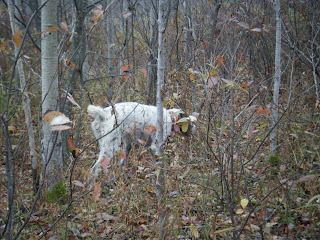Our first day dawned gray and cool, but the older dogs knew the purpose and anxiously waited near the door. Up there in the big woods every day starts with one of my lumberjack breakfasts, so they were forced to wait. Methodically, things were gathered and piled near the door to later put in the truck. It seems something is always forgotten.
Two dogs rode on the backseat, my younger GWP, Colby, and Georgia, a friend’s five-month-old GSP that came along for the week. Chara, my oldest GWP, rides on the passenger side next to me. She, better than the rest, knew the routine.
Yellow leaves still lingered on some of the poplars, and green leaves defiantly clung to roadside apples, but most of the trees were bare. Heavily loaded logging trucks passed us on the highway, a good sign in difficult economic times. And timber harvesting provides great cover for ruffed grouse and woodcock.
 About four miles up a logging road I parked in an old logging yard, one that provided great hunting the previous fall. The views from there are spectacular, with rolling hills to the eastern horizon, and make the stop worthwhile if for nothing else. To the west, north, and east of the yard the trees are about twenty feet tall, maybe logged over about fifteen or twenty years earlier, but to the south the timber is older, perhaps cut sixty or more years ago.
About four miles up a logging road I parked in an old logging yard, one that provided great hunting the previous fall. The views from there are spectacular, with rolling hills to the eastern horizon, and make the stop worthwhile if for nothing else. To the west, north, and east of the yard the trees are about twenty feet tall, maybe logged over about fifteen or twenty years earlier, but to the south the timber is older, perhaps cut sixty or more years ago.
I let the three dogs out, corralling each to put on an orange collar with a bell. With three dogs there definitely would be pandemonium and bumped birds, but I knew they all needed to blow off steam. Following an old tumbling stream, we hunted up the hill.
Chara covered the ground like the old pro she is, working the cover and tasting the air. Colby hunted hard too, but at only two hasn’t figured out all of the tricks. Little Georgia sometimes followed Chara, sometimes Colby, but often followed her own instincts. A bit of independence is a good thing.
Everything in the woods dripped from the previous night’s rain, but the dogs never seemed to notice. We worked the edge of the cutting, and then out into the cut toward a cluster of softwood trees, which might provide shelter for grouse. Nothing. Working back toward the older growth, we hunted the edge of a softwood stand and then around back toward the truck. Still nothing. Soaked to my hide, I was ready for the truck’s heater, yet the dogs’ enthusiasm never wavered.
About a mile down the road, and surrounded by an old clearcut, a dense stand of spruce and fir spelled shelter for partridge on a stormy night. I parked and let out the girls. They plunged into the mesh of branches and I tried to follow.
A bird thundered away unseen ahead of us, and then I heard Chara’s bell stop. Colby and Georgia were working off to my right and out of sight. Wet, cold, branches clawed at my clothes as I hurried toward Chara. About the time I could glimpse a piece of the white dog through the green needles I heard the bird leave.
Coffee for me and fuel for all of us back at the truck!
The logging road took us up over a hill and along a ridge, into miles from anywhere. I found a side road that led into country that looked very good on Google Earth, parked, and started hunting up the road with all three dogs. The country looked perfect, and probably deserves another look sometime, but we only found one partridge that flushed ahead of us and one woodcock that Chara pointed with Colby honoring.
Everywhere I stepped seemed to be spongy, saturated to the point of soupy from the previous rain, and then rain started to fall again. With tired aching legs I drove out of the woods, the dogs all curled up on their seats. A few flakes of snow mixed with the rain at higher elevations, making it easier to call it quits for a while.
It was time to go back to the house and take a nap.






